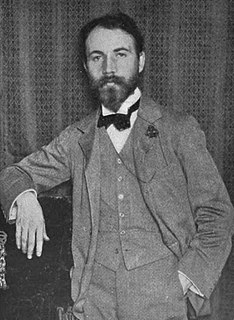
Bernard Berenson was an American art historian specializing in the Renaissance. His book The Drawings of the Florentine Painters was an international success. His wife Mary is thought to have had a large hand in some of the writings.

Vittore Carpaccio was an Italian painter of the Venetian school, who studied under Gentile Bellini. He is best known for a cycle of nine paintings, The Legend of Saint Ursula. His style was somewhat conservative, showing little influence from the Humanist trends that transformed Italian Renaissance painting during his lifetime. He was influenced by the style of Antonello da Messina and Early Netherlandish art. For this reason, and also because so much of his best work remains in Venice, his art has been rather neglected by comparison with other Venetian contemporaries, such as Giovanni Bellini or Giorgione.

La Belle Ferronnière is a portrait of a lady, usually attributed to Leonardo da Vinci, in the Louvre. It is also known as Portrait of an Unknown Woman. The painting's title, applied as early as the seventeenth century, identifying the sitter as the wife or daughter of an ironmonger, was said to be discreetly alluding to a reputed mistress of Francis I of France, married to a certain Le Ferron. Later she was identified as Lucretia Crivelli, a married lady-in-waiting to Duchess Beatrice of Milan, who became another of the Duke's mistresses.

Giovanni Battista Cima, also called Cima da Conegliano, was an Italian Renaissance painter, who mostly worked in Venice. He can be considered part of the Venetian school, though he was also influenced by Antonello da Messina, in the emphasis he gives to landscape backgrounds and the tranquil atmosphere of his works. Once formed his style did not change greatly. He mostly painted religious subjects, often on a small scale for homes rather than churches, but also a few, mostly small, mythological ones.

Sir Herbert Frederick Cook, 3rd Baronet was an English art patron and art historian.

Villa I Tatti, The Harvard Center for Italian Renaissance Studies is a center for advanced research in the humanities located in Florence, Italy, and belongs to Harvard University. It houses a collection of Italian primitives, and of Chinese and Islamic art, as well as a research library of 140,000 volumes and a collection of 250,000 photographs. It is the site of Italian and English gardens. Villa I Tatti is located on an estate of olive groves, vineyards, and gardens on the border of Florence, Fiesole and Settignano.

Madonna with Child is a painting by the Italian Renaissance artist Filippo Lippi. The date in which it was executed is unknown, but most art historians agree that it was painted during the last part of Lippi's career, between 1450 and 1465. It is one of the few works by Lippi which was not executed with the help of his workshop and was an influential model for later depictions of the Madonna and Child, including those by Sandro Botticelli. The painting is housed in the Uffizi Gallery, Florence, Italy, and is therefore commonly called “The Uffizi Madonna” among art historians.
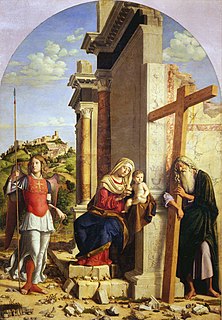
The Madonna and Child with Saints Michael the Archangel and Andrea is a Cima da Conegliano painting oil on panel dating from c. 1496–1498, and preserved at the Galleria nazionale di Parma.

Saints Roch, Anthony Abbot and Lucy or Three Saints is a 1513 oil on canvas painting by Cima da Conegliano, which is now in the collection of the Metropolitan Museum of Art in New York.
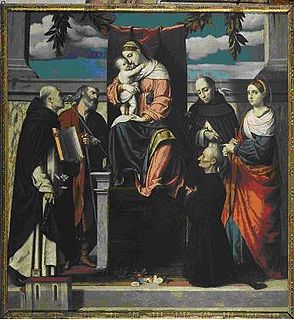
The Orzinuovi Altarpiece or Enthroned Madonna and Child with Saints Dominic, Joseph, Vincent Ferrer, Lucy and a Commissioner is a 1525–1530 oil on canvas painting by Moretto da Brescia on the wall of the chancel of the church of San Domenico in Orzinuovi.
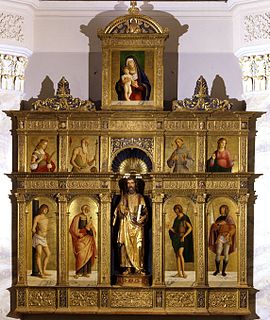
Olera Altarpiece is an oil on panel nine-panel altarpiece by Cima da Conegliano, created c. 1486–1488, housed in the parish church in Olera.

The Conegliano Altarpiece or Madonna and Child with Angels and Saints is an oil painting produced in 1492 by Cima da Conegliano as the high altarpiece for the Duomo di Conegliano in his birthplace.

Madonna and Child is an oil on panel painting by Cima da Conegliano, created c. 1504, that now hangs in the Uffizi in Florence. It has an early copy attributed to Antonio Maria da Carpi, now in the Musei civici di Padova.

Madonna and Child is an oil on panel painting by Cima da Conegliano, from 1504, now in the Museo nazionale atestino in Este. It is very similar to the same artist's Uffizi Madonna. It is the most important pictorial work in the museum, since it is mainly dedicated to archeology.

Antonio Maria da Carpi was an Italian Renaissance painter.
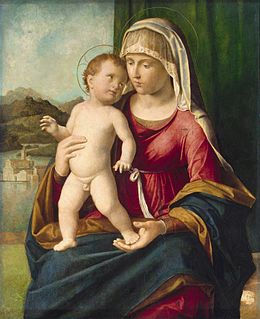
Madonna and Child is a 1496-1499 oil on panel painting by Cima da Conegliano. Previously in the L.M. and K.L. Kochubey collection, it was seized by the Soviet Russia's State Museum Fund and in 1921 handed to the Hermitage Museum in Saint Petersburg, where it still hangs.

Madonna and Child Enthroned with Two Male Saints is a 1489 oil on panel painting by Cima da Conegliano, previously owned by the church of San Dionisio in the Zermen district of Feltre and now in the Museo Civico in that town.

Madonna and Child with Saint Jerome and Saint John the Baptist is a 1492-1495 oil on panel painting by Cima da Conegliano, now in the National Gallery of Art (NGA) in Washington.

The Sacred Conversation or Madonna and Child Enthroned with praying brothers and devotees, Saint Sebastian, Saint John the Baptist, Saint Mary Magdalene and Saint Roch is a 1490 oil on panel painting by Cima da Conegliano, now in the Pinacoteca di Brera in Milan.
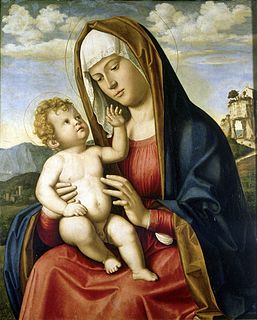
Madonna and Child is a 1495-1497 oil on panel painting by Cima da Conegliano, now in the Petit Palais in Paris. It was owned in London by Sir William Abdy then in Paris by Edward Tuck, the American vice-consul there, who gave it to its present owner in 1930.




















